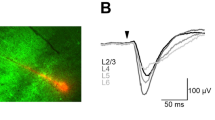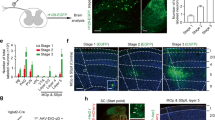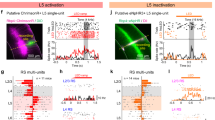Abstract
THERE have been conflicting reports concerning the action of strychnine on the recurrent inhibition of single cortical pyramidal tract (PT) neurones of the cat. On one hand the recurrent inhibitory hyperpolarization is apparently depressed, or even reversed in polarity, by strychnine administered topically to the cortical surface1–4. In contrast, when administered intravenously in doses sufficient to eliminate most types of spinal postsynaptic inhibition, strychnine hydrochloride has no effect on cortical recurrent inhibition, which in the absence of intracellular records can be measured as the ‘pause’ induced, by brief tetanic stimulation of the medullary pyramids, in firing which is spontaneous or evoked by amino-acids5. Differences in the susceptibility of inhibitory processes to strychnine may reflect the operation of different inhibitory transmitters, and thus it is important to determine whether or not cortical inhibition resembles spinal postsynaptic inhibition in its sensitivity to strychnine.
This is a preview of subscription content, access via your institution
Access options
Subscribe to this journal
Receive 51 print issues and online access
$199.00 per year
only $3.90 per issue
Buy this article
- Purchase on Springer Link
- Instant access to full article PDF
Prices may be subject to local taxes which are calculated during checkout
Similar content being viewed by others
References
Pollen, D. A., and Ajmone-Marsan, C. J., Neurophysiol., 28, 342 (1965).
Stefanis, C., and Jasper, H., Intern. J. Neuropharmacol., 4, 125 (1965).
Sawa, M., Maruyama, N., Kaji, S., and Nakamura, K., Japan. J. Physiol., 16, 126 (1966).
Pollen, D. A., and Lux, H. D., J. Neurophysiol., 29, 369 (1966).
Crawford, J. M., Curtis, D. R., Voorhoeve, P. E., and Wilson, V. J., Nature, 200, 843 (1963).
Biscoe, T. J., and Curtis, D. R., Science, 151, 1230 (1966).
Crawford, J. M., and Curtis, D. R., J. Physiol., 186, 139 (1966).
Stefanis, C., and Jasper, H., J. Neurophysiol., 27, 828 (1964).
Kubota, K., Sakata, H., Takahashi, K., and Uno, M., Proc. Japan. Acad., 41, 195 (1965).
Curtis, D. R., and Crawford, J. M., Nature, 206, 516 (1965).
Krnjević, K., and Phillis, J. W., J. Physiol., London, 166, 296 (1963).
Crawford, J. M., and Curtis, D. R., J. Physiol., 186, 121 (1966).
Ramony Cajal, S. M., Histologie du Systéme Nerveux de d'Homme et des Vertebrates, 2, 556 (Maloine, Paris, 1911).
Szentagothai, J., Symp. Biol. Hung., 5, 251 (1965).
Colonnier, M. L., in Brain and Conscious Experience (edit. by Eccles, J. C.) (Springer, New York, 1966).
Author information
Authors and Affiliations
Rights and permissions
About this article
Cite this article
BISCOE, T., CURTIS, D. Strychnine and Cortical Inhibition. Nature 214, 914–915 (1967). https://doi.org/10.1038/214914a0
Issue Date:
DOI: https://doi.org/10.1038/214914a0
This article is cited by
-
Changes in membrane potential and postsynaptic potentials evoked by strychnine in neocortical neurons
Neurophysiology (1993)
-
Role of inhibitory processes in shaping functional characteristics of neurons of the vibrissae projection area of the somatosensory cortex in the cat
Neuroscience and Behavioral Physiology (1988)
-
Prolonged negative surface potentials of the cat sensomotor cortex and responses of neurons and glial cells
Neuroscience and Behavioral Physiology (1986)
-
Action of strychine on evoked potentials and postsynaptic responses of cat sensomotor cortical neurons
Neurophysiology (1985)
-
Effect of intracortical chemical stimulation on spontaneous sensomotor cortical unit activity in cats
Neurophysiology (1983)
Comments
By submitting a comment you agree to abide by our Terms and Community Guidelines. If you find something abusive or that does not comply with our terms or guidelines please flag it as inappropriate.



